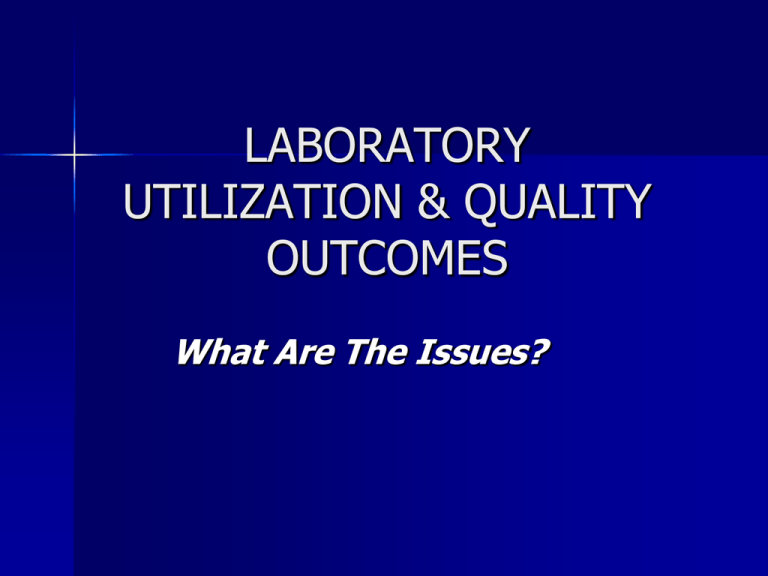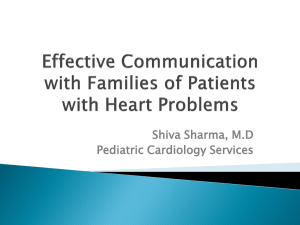Utilization Issues
advertisement

LABORATORY UTILIZATION & QUALITY OUTCOMES What Are The Issues? Impetus For Greater Control Cost of health care Solvency of Medicare program Medical necessity rules Consumer demands Employers and patients Failures In U.S. Health Care System No coordination between major players Vested interests drive medical decisions Little interest in “whole person”, prevention and wellness Limited resources No system Dartmouth Studies The level of physicians and hospital beds drive demand Physician and hospital preference, not patient need, drive health care services in a community The number of surgical procedures vary geographically Likelihood of a diagnosis varies by location Support Study Many Americans die in hospitals, alone and in pain, after receiving treatment regimens undertaken with known unfavorable odds Regional Variations in Diagnostic Practices There is substantial regional variability in test ordering practices that cannot be explained by case mix Song, Y. et al. (2010). – New England Journal of Medicine. http://www.nejm.org/doi/pdf/10.1056/NE JMsa0910881 Diagnosis And Management Of Polycythemia Vera In the era since the Polycythemia Vera Study Group formulated its recommendations Significant variations in diagnostic and therapeutic approach were evident by region, practice type, specialty, and clinical experience. Streiff et al. Blood February 15, 2002 vol. 99 no. 4 1144-1149 Future Needs Baby boomers demanding disease prevention Controversies about a variety of environmental effects on health Obsession with weight Obsession with exercise Popularity of self-testing Internet access to range of medical information New Attitude Emphasis on prevention and wellness Skepticism for physicians and health care systems Reluctantly aging population Primary Questions How do we control utilization of our services? – Control, not limit What knowledge do healthcare providers need to use laboratory services appropriately? What We Know Facts Anecdotes Studies Overutilization Study in APRIL 1998 Issue of American Journal of Medicine Supported by Agency for Health Care Policy and Research Many clinical laboratory tests redundant Review of 6,000 charts looking for 12 standard tests Chart revealed no clinical need for 92% of repeats Abnormal Test Results Study in February 1996 Archives Of Internal Medicine 36% of physicians do not always notify patients of abnormal lab results Some wait till next visit Most don’t document communicating the results to the patient Abnormal Test Results 28% of physicians always notify patients of normal and abnormal results 72% let patients assume that “no news is good news” Lack of follow-up can have a negative effect on patient care Physician Ordering Patterns Quest to collect data Gather information to justify decisions Avoid criticism for not ordering a test Traditional orders – How they were taught Physician Ordering Many studies to change behavior have been conducted Most work during the intervention but behavior reverted after study stopped Benchmark Information Many common preoperative tests not of value Drug utilization costs drop with lab information Cost to diagnose and treat suspected MI reduced with lab tests Benchmark Information Lifetime expenses/diabetic decrease with control of disease through close monitoring of glucose and glycohemoglobin PAP testing - more than 20 years of data support screening benefits Benchmark Information Needed Focus diagnoses Disease/organ specific Effectively prescribe Direct optimal therapy Disease progress Drug levels Treatment response Optimize wellness Successful Strategies Provide test costs at order entry Change order forms Algorithms, reflex testing, pathways, case management Financial incentives Physician education/consultation Evidence-based Medicine Support some strategies? Use current, best evidence to make patient care decisions Conduct research & meta-analyses Clinician must know how to access, read and interpret valid research “First, payers want appropriate utilization for expensive genetic and molecular assays,” observed Zubiller. “Labs are perfectly positioned to work with clinicians at the time of a test order to determine if that genetic test is appropriate for that patient. Doing so could have a dramatic impact on the follow-on care decisions. This will require labs to be more interactive with their client physicians, and integrated informatics for clinical decision support is one way to deliver this added value service. Matthew Zubiller, Vice President and General Manager of Advanced Diagnostic Management, a business unit of McKesson Corporation. That is why we see payers beginning to implement utilization management requirements like pre-authorization and notifications MuirLab is the core laboratory and outreach laboratory service of the John Muir Health System. It has implemented an evidence-based automated diagnostic platform that enables it to collaborate in real-time with providers and payers and ensure that the most appropriate tests were being ordered by physicians at the point of care. This resulted in improved utilization of clinical tests and increased revenues, thanks to a marked decrease in claims denials. CDC Projects 2007 CDC Institute Integration Workgroup to focus on better integration of laboratory medicine in the health care continuum Need to optimize utilization of laboratory services for better patient care Now called Clinical Laboratory Integration into Healthcare Collaborative (CLIHC)TM CLIHCTM Workgroup Co-Lead: John Hickner, MD, MSc University of Chicago Jim L. Meisel, MD, FACP Boston Medical Center Co-Lead: Michael Laposata, MD, PhD Elissa Passiment, EdM Vanderbilt University Hospital American Society for Clinical Laboratory Science Paul Epner, MEd, MBA Paul Epner, LLC Brian Smith, MD Yale School of Medicine Marisa B. Marques, MD University of Alabama at Birmingham CLIHCTM Workgroup Support CDC: Diane Bosse MariBeth Gagnon Maryam Daneshvar Anne Pollock Julie Taylor* Pam Thompson Nancy Cornish Others Participating in CLIHCTM Projects Samir Aleryani, PhD Vanderbilt University Medical Center Robert D. Hoffman, MD, PhD Vanderbilt University Medical Center Julian Barth, MD University of Leeds, United Kingdom Katherine Kahn, MD Rand Corporation and UCLA Allison Floyd, MD Vanderbilt University Medical Center Mario Plebani, MD University of Padua, Italy John Fontanesi, PhD University of California at San Diego George A. Fritsma, MS MT (ASCP) University of Alabama at Birmingham John A. Gerlach, PhD Michigan State University Mitch Scott, PhD Washington University Oxana Tcherniantchouk, MD Cedars-Sinai Medical Center CLIHCTM Key Projects Clinician Test Selection & Result Interpretation – Diagnostic Algorithms – Nomenclature Project – Survey of Clinicians’ Challenges – Medical Errors related to Laboratory Tests Medical School curriculum content pertinent to laboratory services Review of the Literature The reports showing that errors in test selection and result interpretation can jeopardize patient safety are on the rise Allison Floyd, MD and Michael Laposata, MD, PhD, Vanderbilt University Medical Center, unpublished data Diagnostic Algorithms Goal: Demonstrate complexity of selecting the appropriate laboratory test Understand the most effective testing strategies Diagnostic Algorithms Three clinical pathologists with expertise in coagulation created diagnostic laboratory test algorithms to guide evaluation of patients with a prolonged Partial Thromboplastin Time (PTT) and a normal Prothrombin Time (PT) The 6 algorithms addressed: – – – – age (adult versus newborn) patient location (inpatient or outpatient) symptoms (none, bleeding or thrombosis) timing of the abnormal PTT result (recent versus extended period of time) Diagnostic Algorithms CDC has developed an app for iPhones that physicians can use to determine what coagulation tests to order for some of the algorithms – Working on remaining ones Need to now address algorithms for new drugs prescribed Expect to produce 25 apps Pathways Originate from professional societies, federal & state agencies and managed care 28 states require guidelines for health plans serving Medicaid Success depends on implementation process Pathways STUDY IN PEDIATRIC ANNALS, APRIL 1998 Guidelines must be implemented with education, reminders, & incentives Must be consistent with current practice Do not always have desired impact on savings or improvement of care Nomenclature Goal: Demonstrate the complexity of test selection – Multiplicity - Hepatitis B surface antibody HBs Antibody, Hepatitis Bs Ab, HBG, Anti-HBs – Complexity - lupus anticoagulant – not for lupus Developed a flow chart and tables demonstrating: – Complexity – Vitamin D – Breadth – Commonly ordered tests – Depth – Coagulation 36 Nomenclature Test naming could be based on: – – – – Disease association Method used to perform the test Name of developer Inappropriate names (i.e. no link between name and what is being tested) Multiple test name abbreviations – Many evolved from implementing Laboratory Information Systems Existing nomenclature options for vitamin D and its multiple forms : In addition – Vitamin D2 Ergosterol Vitamin D3 The number of abbreviations Cholecalciferol created for laboratory information 25-0H vitamin D2 25-0H vitamin D3 systems for vitamin D and its 25-0H vitamin D multiple forms is almost limitless 25 hydroxy vitamin D2 25 hydroxy vitamin D3 25 hydroxy vitamin D 1,25 (OH)2 vitamin D2 1,25 (OH)2 vitamin D3 1,25 (OH)2 vitamin D 1,25 dihydroxy vitamin D2 1,25 dihydroxy vitamin D3 1,25 dihydroxy vitamin D Vitamin D 25 Hydroxy D2 and D3 Vitamin D 1,25 Dihydroxy Article Published Journal of General Internal Medicine Decoding Laboratory Test Names: A Major Challenge to Appropriate Patient Care – March 2013 Article cited on the Agency for Healthcare Research and Quality (AHRQ) Patient Safety Network (PSNet) Next Steps Summit to connect IT minds and needs of all users of clinical laboratory testing Working towards a Google-like search tool to present users with the correct test names Clinicians’ Challenges in Test Ordering and Results Interpretation Goal: Raise awareness of the challenges clinicians face in test ordering and result interpretation Phase 1 - Conduct three focus groups targeting internal, family, and general medicine practitioners Phase 2 - Using information from focus groups in Phase 1, conduct a national survey of clinicians 41 To understand primary care needs and issues, three focus groups were conducted The results are suggestive of actions that laboratory professionals can take to improve clinician performance To validate findings and gain greater insights into needs, the CDC commissioned a national survey of primary care physicians – National sample of Family Practice and Internal Medicine physicians: target sample size of 1600 – Results collected in 2011 42 Focus Groups Summary Primary care physicians are comfortable selecting from a small working repertoire of common tests “Interpretation and ordering tests, I usually don’t have a problem with that. For the most part I know what to order.” “I may order 20 tests commonly and I may order an additional 10-20 tests [occasionally], so I may be using 40 tests that I feel comfortable that I’m not wasting time or money or resources.” 43 Challenges/ Barriers Test Ordering Insurance and cost limitations Issues with accessing and communicating with laboratories Variations in test names Variable and nebulous practice guidelines 44 Enablers Test Ordering Electronic resources Access to peers and colleagues Access and relationships with laboratory professionals Availability of practice guidelines, algorithms, etc. 45 Challenges/ Barriers Result Interpretation Insurance and cost limitations Varying practice guidelines and methodologies Difficulties in accessing and communicating with laboratory professionals Inconsistency of laboratory test results with clinical presentation Inadequate laboratory reporting and documentation 46 Enablers Result Interpretation Access to electronic results and resources Access to peers and colleagues Access to laboratory professionals Follow-up testing information and reflex testing, when appropriate 47 Focus Group Summary Physicians are comfortable with selecting from a small working repertoire of common tests When results did not fit their suspected diagnosis, physicians relied on combination of patient presentation and own diagnostic instincts more than the laboratory results Laboratory consultation was a useful resource when the physician had effective and consistent access to laboratory services and were comfortable with laboratory professionals Electronic resources are becoming more important, with level of utilization dependent on ease of availability and a culture that encourages their use 48 Focus Groups Summary When results did not fit their suspected diagnosis, physicians relied on combination of patient presentation and own diagnostic instincts more than the laboratory results “Patient symptoms trump the lab results” 49 Focus Groups Summary Laboratory consultation was a useful resource when the physician had effective and consistent access to laboratory professionals but this was not common “Most of us don’t call the lab, we call a specialist” “It hasn’t even occurred to me to call a pathologist to ask what test to order. I wouldn’t have even considered It as an option” You’re lucky if you have someone answer you but most of the time you have a machine or they’ll put you on hold for an extended time period 50 Focus Groups Summary Laboratory consultation was a useful resource when the physician had effective and consistent access to laboratory professionals but this was not common “Most of us don’t call the lab, we call a specialist” “It hasn’t even occurred to me to call a pathologist to ask what test to order. I wouldn’t have even considered It as an option” You’re lucky if you have someone answer you but most of the time you have a machine or they’ll put you on hold for an extended time period 51 Phase 2 - Clinicians’ Survey Methods: – National sample of Family Practice and Internal Medicine physicians drawn from AMA Master File – Target sample size of 1600 – Survey delivered via Web Status: Manuscript submitted to a few journals 52 What we don’t know What is the prevalence of diagnostic errors impacted by the testing process? – Failure to order necessary tests – Ordering of unnecessary tests – Inappropriate utilization of test results What are effective interventions that reduce diagnostic errors and could be initiated by laboratory professionals? – What settings are appropriate for these interventions? – What limitations exist in the use of these interventions? – What new sources of errors are created by the interventions? Paul Epner, Diagnostic Errors in Medicine, October 25, 2010 Improvements in Clinicians’ Test Selection and Result Interpretation (ITSRI) Lead – Paul Epner, MEd, MBA Goal: Demonstrate the effect of improvements in laboratory test selection and result interpretation on diagnostic errors Methods: Develop methods to measure the effect of laboratory test selection and result interpretation on diagnostic errors Conduct pilot studies to determine the effect of improvements in laboratory test selection and result interpretation on diagnostic errors Vanderbilt University Medical Center Unpublished Study* Reviewed one week of consultation requests 53 cases total – 29 cases had appropriate test orders (55%) – 19 cases had incomplete test orders (36%) – 5 cases had inappropriate test orders (9%) Of 24 cases where tests were added or deleted following consultation, the diagnosis was impacted in 2 cases. The timing of the diagnosis in the other cases was not impacted only because of the near real-time addition of tests. *Information and analysis provided by Jennifer M. Giltnane, MD, PhD and Michael Laposata, MD, PhD, Vanderbilt University Medical Center Outcomes Vs Indicators Outcomes require measurement Measurements, to be accurate, must compare large, like populations over a period of time Few health care plans are that comparable. Challenges Characteristics of population, such as age, health status, comorbidities, etc. Differ Need to follow patients five to twenty years and few patients stay with one health plan that long Challenges Illness is rare in the general population so the number of individuals needed to conduct a valid study may not be available in each health plan Health informatics poor; clinical information not captured Laboratory Medicine Education in U.S. Medical Schools Required courses in 57% (68/120) of schools Few schools report no training at all (2 -4%) An ad hoc committee of The Academy of Clinical Laboratory Physicians and Scientists Proposed medical student laboratory medicine curriculum Developed: Goals and objectives for training Guidelines for instructional methods Examples of how outcomes can be assessed Smith, Brian R, et. al.; Educating Medical Students in Laboratory Medicine A Proposed Curriculum; AJCP; 2010: 133: 533-542 Survey of U.S. Medical Schools Project Leads –Brian Smith, MD and John Hickner, MD, MSc Goal: Raise awareness to the gaps in US medical school curricula and laboratory medicine training Methods: Survey all 133 allopathic and 26 osteopathic U.S medical schools Recruit one medical student (via AMSA) per school to help complete the survey 60 Clinical Pathology Residency Education Goal: Establish the nature and amount of clinical consultation education provided to clinical pathology residents Raise awareness to the gaps in, and solutions to improve clinical pathology residency education Method: Conduct observational study of academic institutions assessing clinical pathology resident training activities Clinical Pathology Residency Education Results: 14 Accredited programs contacted – invited to visit 3 Some training programs have focal areas of consult activity Many programs not prepared to develop meaningful consultative roles for residents in laboratory medicine Obstacle - Limited # of doctoral level laboratory directors to teach residents Need to obtain more data to substantiate the results and identify model programs Successful Strategies Physician involvement Laboratory professionals commitment and involvement Laboratory utilization committee Track by physician, pathway, encounter, like pharmacy and surgery The Future Is Bright Laboratory testing provides patientspecific information necessary for the prevention, diagnosis, treatment, and management of disease or establishment of health. Other Initiatives Development of evidence-based methods to identify and evaluate Best Practices in Laboratory Medicine. http://wwwn.cdc.gov/dls/bestpractices /LabBestPractice.pdf







